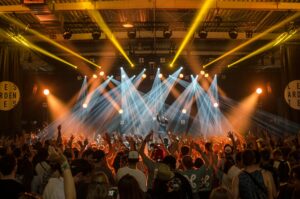Tokyo, known for its towering skyscrapers and bustling streets, also harbours a rich underground music scene that pulses with the heartbeat of the city’s creative and rebellious spirit. This scene, thriving in the shadow of the mainstream J-Pop and idol culture, offers a stark contrast with its fiercely independent ethos and innovative sounds. This article explores the historical context, key genres, influential venues, and the cultural impact of Tokyo’s underground music scene.
Historical Context of Tokyo’s Underground Scene
The origins of Tokyo’s underground music scene can be traced back to the post-World War II era, when jazz introduced by American soldiers began influencing local musicians. This evolved through the 1960s and 70s as youth culture began to rebel against societal norms, embracing genres like punk, rock, and experimental music. By the 1980s and 1990s, Tokyo had established a vibrant underground scene that was not only about music but also a form of resistance against the conformist pressures of Japanese society.

Key Genres of Tokyo’s Underground Music
- Punk and Hardcore: Tokyo’s punk scene emerged in the late 70s and early 80s, inspired by bands from the UK and the US. It quickly grew into a more diverse hardcore scene, with bands like GISM, Gastunk, and Cobra. These groups were known for their aggressive sounds and anti-establishment lyrics, reflecting the frustrations of the youth.
- Experimental and Noise Music: Tokyo is a global epicenter for experimental and noise music, with artists like Merzbow and Masonna pushing the boundaries of what music can be. This genre’s abrasive and unconventional sounds make it a staple of the underground, challenging listeners’ perceptions and expectations.
- Hip-Hop: While not initially associated with Tokyo’s underground, Japanese hip-hop has grown from the streets of Shibuya and Harajuku into a formidable part of the underground scene, with artists often discussing themes of social inequality and cultural identity.
Influential Venues and Spaces
The underground scene in Tokyo is anchored by iconic venues that have become cultural landmarks. These include:
- Shibuya Club Quattro: Hosting indie and rock bands, this venue is crucial for up-and-coming artists in the rock and punk scenes.
- SuperDeluxe: Although it closed in 2019, SuperDeluxe in Roppongi was instrumental in fostering experimental music and arts, hosting everything from avant-garde jazz to noise music performances.
- Liquidroom: Located in Shibuya, Liquidroom caters to a diverse array of genres, including electronic, rock, and indie, making it a popular spot for those seeking a taste of Tokyo’s eclectic underground.
Cultural Impact
Tokyo’s underground music scene is more than just an artistic outlet; it’s a vital part of the city’s cultural dialogue. It provides a space for expression and experimentation, often reflecting and reacting to the broader social and economic issues facing Japan. The scene has also significantly influenced mainstream culture, with many underground artists eventually rising to national and even international fame.
Tokyo’s underground music scene is a dynamic and integral part of the city’s cultural landscape. Hidden away in small clubs and back-alley venues, it is a world where artists and audiences come together in a shared experience of exploration and expression. While it might not have the mass appeal of J-Pop or the visibility of the city’s major cultural exports, Tokyo’s underground music scene remains a critical outlet for those pushing the boundaries of what music can represent in contemporary Japanese society. As Tokyo continues to evolve, so too does its underground scene, perpetually redefining itself and its role within both local and global contexts.
Hey there! I’m a self-proclaimed Twitter addict and an unapologetic coffee lover.









